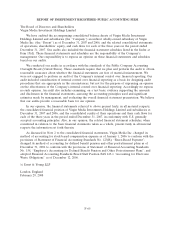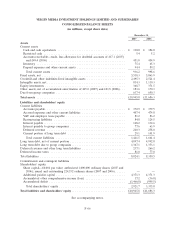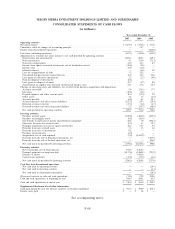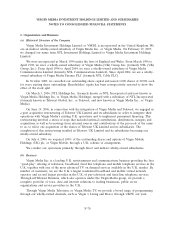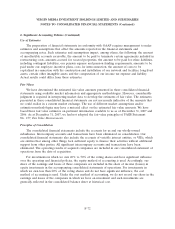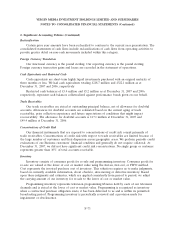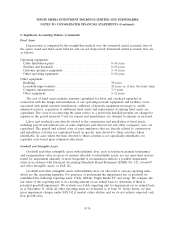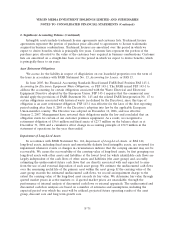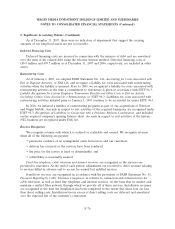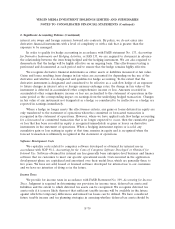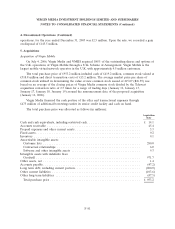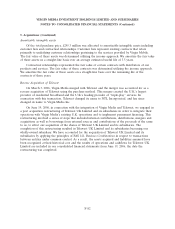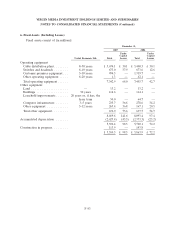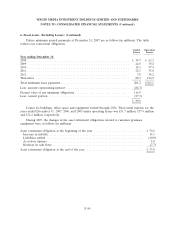Virgin Media 2007 Annual Report Download - page 161
Download and view the complete annual report
Please find page 161 of the 2007 Virgin Media annual report below. You can navigate through the pages in the report by either clicking on the pages listed below, or by using the keyword search tool below to find specific information within the annual report.VIRGIN MEDIA INVESTMENT HOLDINGS LIMITED AND SUBSIDIARIES
NOTES TO CONSOLIDATED FINANCIAL STATEMENTS (Continued)
2. Significant Accounting Policies (Continued)
Intangible assets include trademark license agreements and customer lists. Trademark license
agreements represent the portion of purchase price allocated to agreements to license trademarks
acquired in business combinations. Trademark licenses are amortized over the period in which we
expect to derive benefits, which is principally five years. Customer lists represent the portion of the
purchase price allocated to the value of the customer base acquired in business combinations. Customer
lists are amortized on a straight-line basis over the period in which we expect to derive benefits, which
is principally three to six years.
Asset Retirement Obligations
We accrue for the liability in respect of dilapidation on our leasehold properties over the term of
the lease in accordance with FASB Statement No. 13, Accounting for Leases, or FAS 13.
In June 2005, the Financial Accounting Standards Board issued FASB Staff Position FAS 143-1,
Accounting for Electronic Equipment Waste Obligations, or FSP 143-1. The FASB issued FSP 143-1 to
address the accounting for certain obligations associated with the Waste Electrical and Electronic
Equipment Directive adopted by the European Union. FSP 143-1 requires that the commercial user
should apply the provisions of FASB Statement No. 143 and the related FASB Interpretation No. 47 to
certain obligations associated with historical waste (as defined by the Directive), since this type of
obligation is an asset retirement obligation. FSP 143-1 was effective for the later of the first reporting
period ending after June 8, 2005 or the Directive’s adoption into law by the applicable European
Union-member country. The Directive was adopted on December 12, 2006, and was effective
January 2, 2007. Management have reviewed their obligations under the law and concluded that an
obligation exists for certain of our customer premises equipment. As a result, we recognized a
retirement obligation of £56.6 million and fixed assets of £23.7 million on the balance sheet as at
December 31, 2006 and a cumulative effect change in accounting principle of £32.9 million in the
statement of operations for the year then ended.
Impairment of Long-Lived Assets
In accordance with FASB Statement No. 144, Impairment of Long-Lived Assets, or FAS 144,
long-lived assets, including fixed assets and amortizable definite lived intangible assets, are reviewed for
impairment whenever events or changes in circumstances indicate that the carrying amount may not be
recoverable. We assess the recoverability of the carrying value of long-lived assets, by first grouping our
long-lived assets with other assets and liabilities at the lowest level for which identifiable cash flows are
largely independent of the cash flows of other assets and liabilities (the asset group) and, secondly,
estimating the undiscounted future cash flows that are directly associated with and expected to arise
from the use of and eventual disposition of such asset group. We estimate the undiscounted cash flows
over the remaining useful life of the primary asset within the asset group. If the carrying value of the
asset group exceeds the estimated undiscounted cash flows, we record an impairment charge to the
extent the carrying value of the long-lived asset exceeds its fair value. We determine fair value through
quoted market prices in active markets or, if quoted market prices are unavailable, through the
performance of internal analysis of discounted cash flows or external appraisals. The undiscounted and
discounted cash flow analyses are based on a number of estimates and assumptions, including the
expected period over which the asset will be utilized, projected future operating results of the asset
group, discount rate and long term growth rate.
F-75


